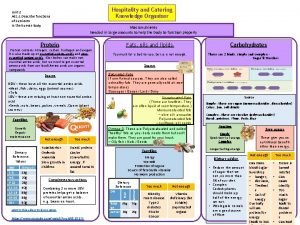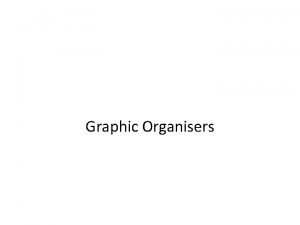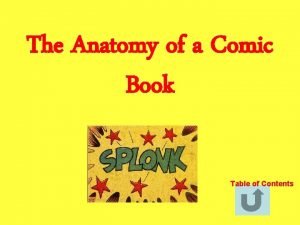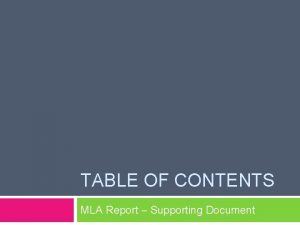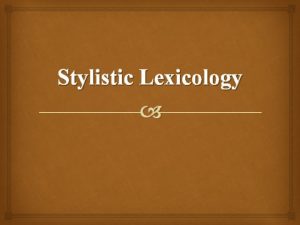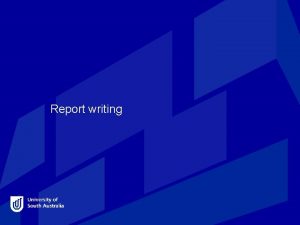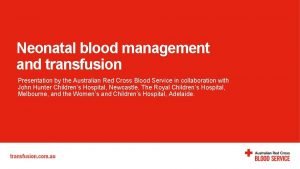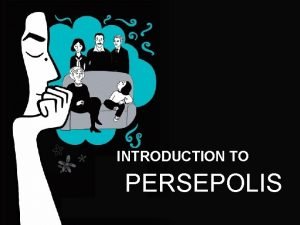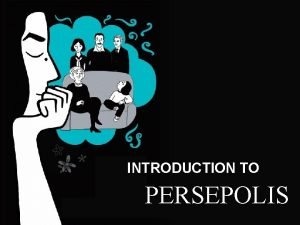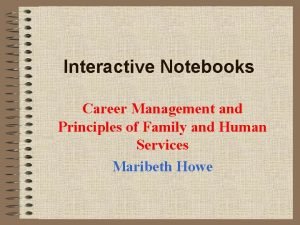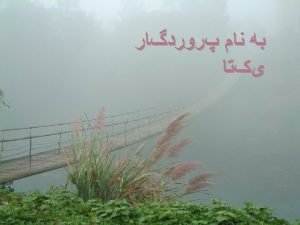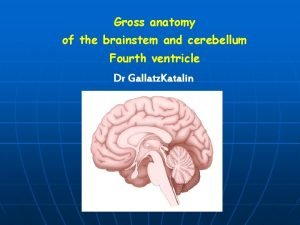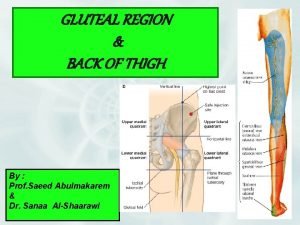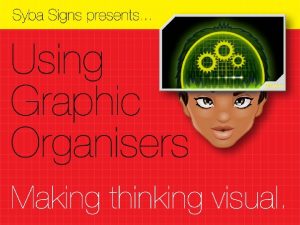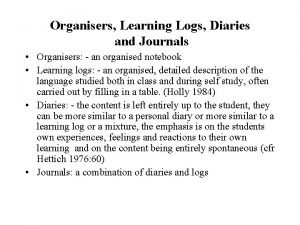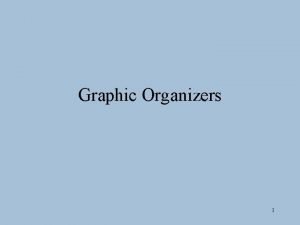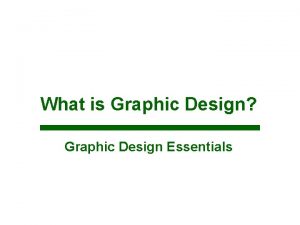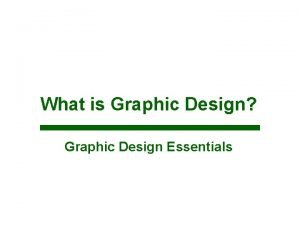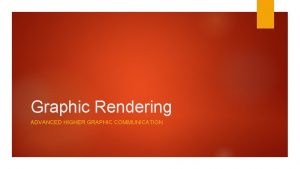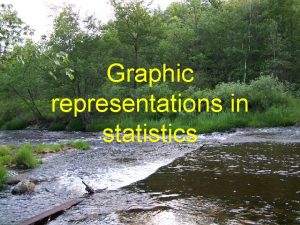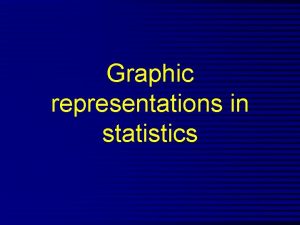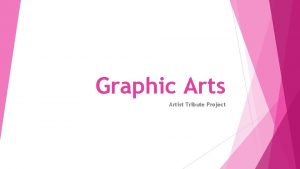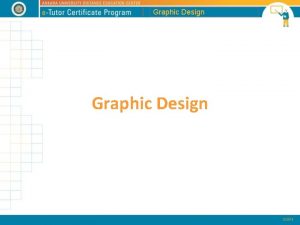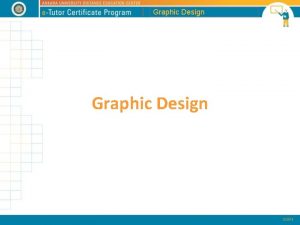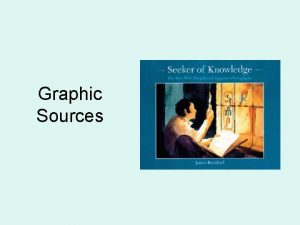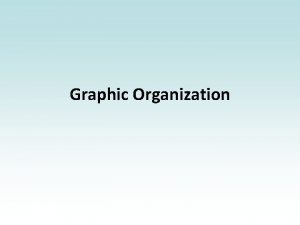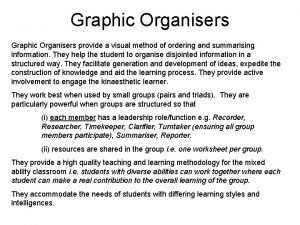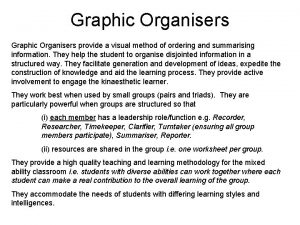Contents Graphic organisers Defined Graphic organisers Advantages Graphic



































- Slides: 35


Contents § § § Graphic organisers - Defined Graphic organisers - Advantages Graphic organisers - Uses Graphic organisers - Application Choices - (depend on the task) § § § Task A – Classifying Task B – Processes, Sequences, Prioritising Task C – Comparing and Contrasting Task D – Cause and Effect Task E – Evaluating or Predicting 3 4 5 6 8 12 19 26 31

Graphic organisers defined Graphic organisers are: § a pictorial way of constructing knowledge § a pictorial way of organising information § a pictorial way of converting disjointed information into a simple-to-read display § a completed graphic organiser conveys complex information in an easy to understand manner

Graphic organisers - advantages Using graphic organisers ensures: § an increased understanding of the topic § an understanding of the relationships between items § an understanding of the meaning of each item § that the most important parts of the information are prioritized § that new ideas are generated § that student thinking skills are developed

Graphic organisers - uses Graphic organisers can be used: § to help analyse and synthesize information § to structure written assignments § to help in problem solving § to assist in decision making § to assist in planning research § when brainstorming ideas § to illustrate prior knowledge on the subject § to categorise information § to gather and record information § to show the students’ thinking Can be used in any subject in the curriculum

Graphic organisers - application Graphic organisers can be applied: § at the beginning of a unit of work e. g. for brainstorming prior knowledge § at the end of a unit of work e. g. a self assessment rubic § to describe a phenomenon § to classify or categorise a phenomena § to compare & contrast facts § to sequence or order ideas § to show causal links between ideas, information § to evaluate and predict

Graphic organisers - choice § The tasks or thinking skills required determines the type of graphic organiser to be used § The following slides give examples of common graphic organisers according to the task involved

Task A Classifying, recalling, brainstorming use Webs § Questions § What is the central idea? § What are the qualities/attributes? § What are its functions? § Choices § 1. Star, 2. Spider, 3. Cloud/cluster

Webs - star Star Use when investigating attributes associated with a single topic, concept or theme

Webs - spider Spider Use when investigating attributes associated with a single topic. This is like a star organiser but with one more level of detail.

Webs - clouds Clouds Use when the topic involves generating ideas, e. g. brainstorming.

Task B To show processes, sequences, prioritizing use chains, cycles and flow charts. § Questions § What happened? § What is the sequence of events? § What are the substages? § Choices 1. Series of events chain, 2. Cycle, 3. Flow chart

1. Chain of events § Series of events chain § Use to describe the stages of something e. g. the life cycle of an insect, a sequence of historical events § Questions § § What is the first event? What are the stages or steps? How do they lead to one another? What is the final outcome?

1. Chain of events § Series of events chain diagram

2. Cycle of events § Use if the topic involves a recurring cycle of events, with no beginning and no end e. g. life cycles § Questions § What are the critical events in the cycle? § How are they related? § In what ways are they self-reinforcing?

2. Cycle of events § Cycle of events diagram

3. Flow chart / sequencing § Flow Chart § Use to describe discrete step, or steps that must be completed in order § Questions § What happened? § What is the sequence of events? § What are the substages?

2. Flow chart / sequencing § Flow chart diagram

Task C To compare and contrast information. § Questions § What are things being compared? § How are they similar? § How are they different? § Choices 1. Venn Diagram 2. T Chart 3. Compare & contrast matrix

1. Venn Diagram § Use to analyze similarities and differences between two things by placing individual characteristics in either the left or right sections, and common characteristics in the overlapping section § Questions § What are the two things being compared? § How are they similar? § How are they different?

1. Venn diagram § Venn diagram example

2. T-chart § T-Chart § Use when analyzing or comparing two aspects of a topic. e. g. Fill out a T-Chart to evaluated the pros and cons associated with a decision § Questions § What are the two things being compared? § How are they similar? § How are they different?

2. T-chart § T-chart example

3. Compare & contrast matrix § Matrix or data chart § Use to show differences and similarities between two things eg people, places, events, ideas § Questions § What are the two things being compared? § How are they similar? § How are they different?

3. Compare & contrast matrix § Matrix diagram example

Task D To show cause and effect § Questions § What are the causes and effects of this event? § What might happen next? § Choices § 1. Fishbone § 2. Cause/effect chain of events § 3. Multiple causes map

1. Webs - fishbone § Fishbone § Used when investigating cause and effect factors associated with a complex event or phenomenon. § Questions: § What are the causes and effects of this event § What might happen next § What are the factors that cause X? § How do they relate?

1. Webs - fishbone § Fishbone example eg: analysing an election, juvenile delinquency

2. Cause and effect chain § Cause and effect chain example One event causes another, which triggers another like a domino effect.

3. Multiple causes map § Multiple causes map example

Task E To evaluate or predict § KWLH § § K = what we know W = what we want to find out L = what we learned H = how can we learn more § Use to help students activate prior knowledge. § Use a KWHL chart before, during, and after reading about a topic

Evaluate/predict § KWHL diagram

Graphic organisers across the curriculum § Graphic organisers can be used to reinforce topics from any subject. Use the examples in this presentation in: § § Maths – e. g. Venn diagrams, slide 21 Science – e. g. Flow charts, slide 18 Literature – e. g. Story boards, slide 34 (next slide) History – e. g. Cycle of events, slide 17 § Better still - create your own organiser!

Storyboards § A graphic look at literature

References § Enchanted Learners. com, Graphic Organizers, viewed 11 th June, 2008, http: //www. enchantedlearning. com/graphicorganizers/ § Graphic Organizers, Education Place, viewed 11 th June, 2008, www. schools. nt. edu. au/larapsch/organisers. htm § Murcoch, K & Wilson, J, (2004), Learning Links, Strategic teaching for the learner-centred classroom, Curriculum Corp, Melbourne. § P. L. Duffy Resource Centre 2006, Trinity College, viewed 12 th June, 2008, http: //search. ninemsn. com. au/results. aspx? form=MICBAF&q=graphic%20 or ganisers The Graphic Organiser, Graphic. org, Viewed 12 th June, 2008, http: //www. graphic. org/ § § Thinking Toolbox: Graphic organisers, 2008, Larapinta Primary School, viewed 12 th June 2008, www. schools. nt. edu. au/larapsch/organisers. htm § Write Design Online Graphic Organizers, viewed 10 th June, 2008, http: //www. writedesignonline. com/organizers/
 Wjec hospitality and catering knowledge organisers
Wjec hospitality and catering knowledge organisers Stair graphic organizer
Stair graphic organizer The organisers staff & recruitment
The organisers staff & recruitment This is a collection of well-defined objects.
This is a collection of well-defined objects. Non sequitur transition
Non sequitur transition Ghost graphic story graphic and wayfinding
Ghost graphic story graphic and wayfinding When organizing your career portfolio you should
When organizing your career portfolio you should Deep perineal pouch contents
Deep perineal pouch contents Febrile non hemolytic transfusion reaction
Febrile non hemolytic transfusion reaction Fresh frozen plasma contents
Fresh frozen plasma contents Middle mediastinum: contents mnemonic
Middle mediastinum: contents mnemonic Popliteal fossa borders
Popliteal fossa borders Posterior mediastinum
Posterior mediastinum The immortal life of henrietta lacks table of contents
The immortal life of henrietta lacks table of contents Contents of internal capsule
Contents of internal capsule Subscapular region of the back
Subscapular region of the back Ark
Ark Comic book table of contents
Comic book table of contents Porta hepatis contents
Porta hepatis contents Mla table of contents
Mla table of contents Stylistic synonyms lexicology
Stylistic synonyms lexicology School magazine cover
School magazine cover Research methodology contents
Research methodology contents Example of appendix in report
Example of appendix in report Platelets transfusion indication
Platelets transfusion indication Posterior mediastinum contents
Posterior mediastinum contents Mediastinum
Mediastinum How to write an indicative abstract
How to write an indicative abstract Persepolis table of contents with page numbers
Persepolis table of contents with page numbers Persepolis table of contents
Persepolis table of contents Interactive notebook table of contents
Interactive notebook table of contents Cryoprecipitate contents
Cryoprecipitate contents Brainstem
Brainstem Spermatic cord covering
Spermatic cord covering Greater sciatic foramen contents
Greater sciatic foramen contents Swot analysis of event venue
Swot analysis of event venue
